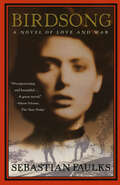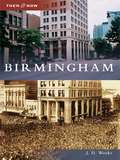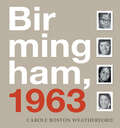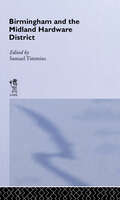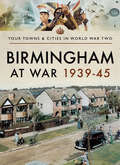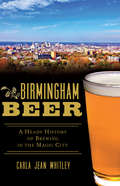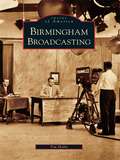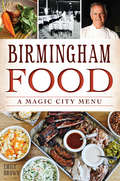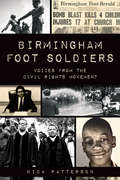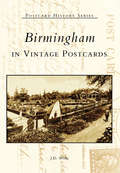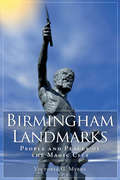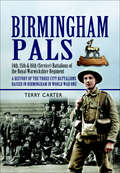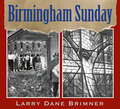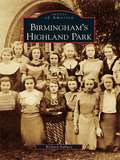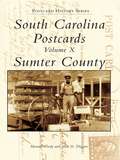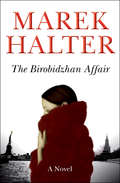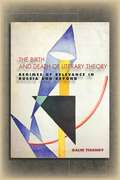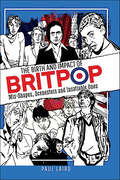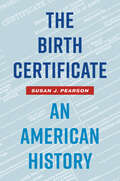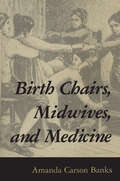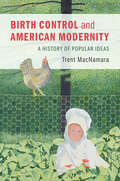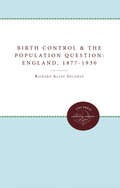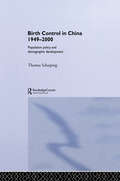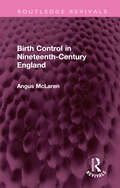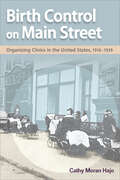- Table View
- List View
Birdsong: A Novel of Love and War (Vintage International)
by Sebastian FaulksPublished to international critical and popular acclaim, this intensely romantic yet stunningly realistic novel spans three generations and the unimaginable gulf between the First World War and the present. As the young Englishman Stephen Wraysford passes through a tempestuous love affair with Isabelle Azaire in France and enters the dark, surreal world beneath the trenches of No Man's Land, Sebastian Faulks creates a world of fiction that is as tragic as A Farewell to Arms and as sensuous as The English Patient. Crafted from the ruins of war and the indestructibility of love, Birdsong is a novel that will be read and marveled at for years to come.
Birmingham
by J. D. WeeksBirmingham's surrounding hills comprise the only place in the world with a plentiful supply of all the ingredients for iron making. This spurred the city of Birmingham's charter in 1871 around the crossing of two railroads. The city's development into a leading industrial center is shown here in photographs and postcard views, some a century old.
Birmingham, 1963
by Carole Boston WeatherfordA poetic tribute to the victims of the racially motivated church bombing that served as a seminal event in the struggle for civil rights. In 1963, the eyes of the world were on Birmingham, Alabama, a flashpoint for the civil rights movement. Birmingham was one of the most segregated cities in the United States. Civil rights demonstrators were met with police dogs and water cannons. On Sunday, September 15, 1963, members of the Ku Klux Klan planted sticks of dynamite at the Sixteenth Street Baptist Church, which served as a meeting place for civil rights organizers. The explosion killed four little girls. Their murders shocked the nation and turned the tide in the struggle for equality. A Jane Addams Children's Honor Book, here is a book that captures the heartbreak of that day, as seen through the eyes of a fictional witness. Archival photographs with poignant text written in free verse offer a powerful tribute to the young victims.
Birmingham and Midland Hardware District: A Series Of Reports, Collected By The Local Industries Committee Of The British Association At Birmingham, In 1865: Edited By Samuel Timmins
by S. TimminsFirst Published in 1967. This is a series of reports on the resources, various products and industrial history of Birmingham and its Midland hardware district. They were collected by the local Industry Committee of the British Association in 1865. The volume gives an idea if not full details, of the extent and variety of the local trades within the radius of thirty miles of Birmingham. The coal and iron of Staffordshire, the chemical products, glass and alkalis and soap of Smethwick, the metal works from the costliest plate and jewellery down to common gilt toys, the engines and machinery exported to all parts of the world to name a few.
Birmingham at War, 1939–45 (Your Towns & Cities in World War Two)
by Julie PhillipsBarely 17 years after the Great War that had brought Britain to its knees, the country was once again asked to make sacrifices and give their all to the war effort. With its strong industrial background, Birmingham was already geared to help manufacture the vehicles that could be adapted for war use, and with the threat of the German Luftwaffe screaming across the skies, it was only right that the production of planes, most notably the spitfire, was ramped up to help protect the British public.While many of its men and women were involved in the forces abroad, many more stayed behind to defend the city, with inhabitants risking their lives by taking up fire hoses, first aid kits, manning antiaircraft guns and positioning barrage balloons in order to save others from the devastating destruction of the Blitz. Meanwhile, the city's children were separated from their families to escape the worst of the bombing and would return from their adventures changed: not all host evacuee families were as kind or as welcoming to their charges as it would appear.Yet not everyone was so patriotic and keen to do their bit, and the opportunity for crime and to fiddle the rations with black market goods was rife. Not even Government issue equipment was off limits, as one Birmingham gang of sandbag thieves demonstrated.For Birmingham, the Second World War was a time of great hardship and sacrifice and the hard work continued for many years after, as its people painstakingly rebuilt parts of the bomb-damaged city.
Birmingham Beer: A Heady History of Brewing in the Magic City (American Palate)
by Carla Jean WhitleyLess than fifteen years after the birth of Birmingham, its brewing history began, and soon saloons dotted nearly every corner. Prohibition, however, decimated the brewing scene for eighty-five years. Although national Prohibition began in 1920, Jefferson County voted to go dry in 1907. Alabama beer saw a brief resurgence after the Brewpub Act of 1992, as craft beer's popularity grew nationwide. But the brewpubs and breweries that emerged struggled against the state's restrictive laws, which included such stipulations as locating brewpubs in historic districts and limiting beer bottle sizes to sixteen ounces. By the time grass-roots lobbying organization Free the Hops formed in 2004 to fight those restrictive laws, every Birmingham brewery had closed. Join author Carla Jean Whitley as she uncovers the struggle to make local beer a Birmingham staple.
Birmingham Broadcasting
by Tim HollisBirmingham, Alabama, has enjoyed a long and distinguished broadcasting history. The city's first radio station aired in 1922, and television arrived in 1949. Both media produced personalities who became household names in the city. Audiences came to know Joe Rumore, Tommy Charles, Country Boy Eddy, Cousin Cliff Holman, Rosemary, Pat Gray, Tom York, and many others as if they were members of their own families. Even the commercials became as memorable as the news, entertainment, talk, and children's shows they interrupted.
Birmingham Food: A Magic City Menu (American Palate)
by Emily BrownBirmingham began as a boomtown filled with immigrants who held on to the best recipes from their homelands. More recently, locals like Frank Stitt and Carole Griffin helped transform the modern southern city into a foodie destination with the best of national trends. Andrew Zimmern visited with his show Bizarre Foods America to tout one of the city's most popular food trucks, Shindigs. Fast casual dining is done with care, and gems like Trattoria Centrale and Bettola are dedicated to local ingredients. Join food writer and restaurant enthusiast Emily Brown as she details the delectable history of food in the Magic City.
Birmingham Foot Soldiers: Voices from the Civil Rights Movement
by Nick PattersonPersonal recollections from everyday people who marched against segregation and injustice in Alabama, risking arrest or worse, in the early 1960s.Martin Luther King Jr., Andrew Young, Fred Shuttlesworth: These are iconic names associated with the Birmingham campaign of the civil rights movement. But there were thousands of others who played crucial roles too, and this volume gives voice to many local residents who also risked their lives for the cause.Myrna Carter Jackson feels no shame about the police record she garnered while demonstrating against the harsh treatment of African Americans in the city. Carolyn Walker Williams, who knew the injustice black people faced in East Birmingham even as a child, was arrested at a protest for the first time while still in school. Gerald Wren grew up in the Smithfield neighborhood, part of which was nicknamed “Dynamite Hill” as a result of the bombings of African Americans’ houses, churches, and schools. Journalist Nick Patterson interviews these and other Birmingham foot soldiers—and recounts the struggle and adversity overcome.Includes photos
Birmingham in Vintage Postcards (Postcard History Series)
by J. D. WeeksAt the start of the 20th century, Birmingham was one of the fastest growing cities in the South, sometimes referred to as the "Magic City." It began as a town located at the intersection of two railroads and then quickly expanded and took in neighboring communities. Around this time, photographers traveled around the United States taking photographs of towns and cities and turning the photographs into postcards. The postcards collected here show historic Birmingham's downtown, hospitals, parks, communities, schools, hotels, and industries. These images serve as a record of everyday life in this bustling Southern city.
Birmingham Landmarks: People and Places of the Magic City (Landmarks)
by Victoria MyersThough the landscape has certainly changed, many of Birmingham's early landmarks--testaments to the steelworkers who built the city after the Civil War, as well as those who have since prospered here--remain. In Birmingham Landmarks, Alabama native VictoriaMyers explores the Magic City's most prominent industrial and cultural features. Step back in time to discover Rickwood Field, one of America's oldest baseball parks, and the Carver Theater, the only venue that allowed African Americans to view first-run movies before the civil rights movement. Find out why Birmingham is known as the Pittsburgh of the South at Sloss Furnaces and learn the secrets of Vulcan, who was commissioned for the 1904 World'sFair and has become one of the state's most recognizable monuments.
Birmingham Pals: 14th, 15th & 16th (Service) Battalions of the Royal Warwickshire Regiment, A History of the Three City Battalions Raised in Birmingham in World War One (Pals Ser.)
by Terry CarterIn the summer of 1914, our finest young men flocked to the colors in Northern towns and cities to answer Lord Kitcheners Call to Arms in a spontaneous burst of enthusiasm and patriotism. The Call appealed to their sense of adventure and offered an escape from the humdrum life of office, factory and mill.The new recruits volunteered with brothers, cousins, friends and work mates. The newly formed units became the focus of local civic pride and soon became known as the Pals. The City of Birmingham formed three such battalions with over 3,000 local volunteers. This book tells their story.Birmingham Pals is a story that covers the full range of human experience in war—the highest courage and bravery, the misery and tedium of trench life, the exhilaration, terror and slaughter involved in going over the top. Above all, it is a story of interest to people of all backgrounds and ages, as a tale of comradeship, which, for many survivors, was to last a life time.
Birmingham Sunday
by Larry Dane BrimnerJane Addams Children's Honor BookNCTE Orbis Pictus Honor BookKirkus Reviews Best Children's Book of the YearThis nonfiction picture book focuses on Birmingham Sunday, a fateful day and significant part of the Civil Rights movement, and places it in historical context.Racial bombings were so frequent in Birmingham, Alabama that it became known as "Bombingham." Until September 15, 1963, these attacks had been threatening but not deadly. On that Sunday morning, however, a blast in the 16th Street Baptist Church ripped through the exterior wall and claimed the lives of four girls. The church was the ideal target for segregationists, as it was the rallying place for Birmingham's African American community, Martin Luther King, Jr., using it as his "headquarters" when he was in town to further the cause of desegregation and equal rights. Rather than triggering paralyzing fear, the bombing was the definitive act that guaranteed passage of the landmark 1964 civil rights legislation.
Birmingham's Highland Park
by Richard DabneyBirmingham's Highland Park originated in the 1880s when a grand boulevard was dug and three lush parks were planned at the northern foothills of Red Mountain. This boulevard was Highland Avenue, at the time the widest street in the South. The development, built within three miles of the center of Birmingham, included the construction of a resort hotel and lake. A dummy line rail system conveyed the populace of The Magic City" out to the beautiful Highland Park neighborhood, where in summer the air was both cooler and cleaner. Although Highland Avenue was lined with mansions of every architectural style, only 12 remain today. Indeed, some Highland Park dwellers have resided for generations in this neighborhood of true character and charm."
Birmingham's Theater and Retail District (Images of America)
by Tim HollisFrom the 1890s to the 1970s, the thriving area of Birmingham between Eighteenth and Twenty-first Streets along First, Second, and Third Avenues was the bustling heart of this quickly growing city. Before the age of the shopping mall, the downtown was the center of retail and entertainment in Birmingham. Along these streets, entrepreneurial immigrants built department stores--including Pizitz and Loveman, Joseph, and Loeb--while the marquees of the Alabama, Ritz, and Lyric theaters, among others, shined over the busy downtown sidewalks.
The Birobidzhan Affair
by Marek HalterA thrilling saga set in the Jewish republic of Birobidzhan At the height of the Red Scare in the 1950s, the House Un-American Activities Committee questions a Russian woman named Marina. She stands accused of being a spy and is suspected of murdering OSS agent Michael Apron. But even more scandalous than the accusations against her is the truth that her interrogation will reveal. In Russia, Marina was a successful actress--and one night, she found herself seduced by Stalin. To avoid a dangerous scandal, she pretended to be Jewish and fled to Birobidzhan, a lost city in the far southeastern corner of the Soviet Union bordering China, originally populated by those escaping the Nazis. This forgotten city was home to a wealth of Jewish culture and also happened to be in an ideal geographical position for the Allied forces to observe Japan's movements in Manchuria. It was there that Marina met and fell in love with Michael Apron. Following a fascinating heroine from Stalinist Russia to the United States during the McCarthy era, this thrilling story of love and espionage shows readers two worlds rocked by political turmoil.This book was translated from the original French by Anna Declerck.
The Birth and Death of Literary Theory: Regimes of Relevance in Russia and Beyond
by Galin TihanovUntil the 1940s, when awareness of Russian Formalism began to spread, literary theory remained almost exclusively a Russian and Eastern European invention. The Birth and Death of Literary Theory tells the story of literary theory by focusing on its formative interwar decades in Russia. Nowhere else did literary theory emerge and peak so early, even as it shared space with other modes of reflection on literature. A comprehensive account of every important Russian trend between the world wars, the book traces their wider impact in the West during the 20th and 21st centuries. Ranging from Formalism and Bakhtin to the legacy of classic literary theory in our post-deconstruction, world literature era, Galin Tihanov provides answers to two fundamental questions: What does it mean to think about literature theoretically, and what happens to literary theory when this option is no longer available? Asserting radical historicity, he offers a time-limited way of reflecting upon literature—not in order to write theory's obituary but to examine its continuous presence across successive regimes of relevance. Engaging and insightful, this is a book for anyone interested in theory's origins and in what has happened since its demise.
The Birth and Impact of Britpop: Mis-Shapes, Scenesters and Insatiable Ones
by Paul LairdRemember the ninteties? Of course you do. Cool Britannia, New Labour, Blur vs Oasis, Geri Halliwell’s Union Flag dress, TFI Friday, “wasssssuuuuuuppppppp”, Opal Fruits turning into Starburst without anyone asking your permission…crazy times. This book doesn’t have anything to say about Geri’s dress or Opal Fruits but it has lots to say about Britpop. But this isn’t a book about the Britpop you think you know about, this is the story of a truly remarkable period of creativity in British guitar music told through the experiences of someone who was there from the first note of “Popscene” through to the run out groove of “This is Hardcore”. This is the story of the Britpop that didn’t make it onto the evening news or the cover of The Face. This is the story of the bands nobody remembers but that everybody should. This is the story of what it was like to be an outsider in 1991 and be too cool for school by 1994. This is the story of a magnesium flash in British popular music that has, for good or ill, defined British guitar music ever since. Here are Flamingoes and Pimlico, Strangelove and David Devant and His Spirit Wife, The Weekenders and Thurman…and Blur, Pulp, Oasis, Sleeper and Elastica too. These are Britpop memories from someone who was actually there. The definitive story of Britpop…
The Birth Certificate: An American History
by Susan J. PearsonFor many Americans, the birth certificate is a mundane piece of paper, unearthed from deep storage when applying for a driver's license, verifying information for new employers, or claiming state and federal benefits. Yet as Donald Trump and his fellow "birthers" reminded us when they claimed that Barack Obama wasn't an American citizen, it plays a central role in determining identity and citizenship.In The Birth Certificate: An American History, award-winning historian Susan J. Pearson traces the document's two-hundred-year history to explain when, how, and why birth certificates came to matter so much in the United States. Deftly weaving together social, political, and legal history, The Birth Certificate is a fascinating biography of a piece of paper that grounds our understanding of how those who live in the United States are considered Americans.
Birth Chairs, Midwives, and Medicine
by Amanda Carson BanksThere was a time when birth was treated as a natural process rather than a medical condition. Before 1800, women gave birth seated in birth chairs or on stools and were helped along by midwives. Then societal changes in attitudes toward women and the practice of medicine made birthing a province of the male-dominated medical profession. In Birth Chairs, Midwives, and Medicine, Amanda Carson Banks examines the history of the birth chair and tells how this birthing device changed over time. Through photographs, artists' renditions of births, interviews, and texts from midwives and early obstetricians, she creates an evolutionary picture of birthing practices and highlights the radical redefinition of birth that has occurred in the last two centuries. During the 1800s the change from a natural philosophy of birth to a medical one was partly a result of heightened understandings of anatomy and physiology. The medical profession was growing, and with it grew the awareness of the economic rewards of making delivery a specialized practice. In the background of the medical profession's rise was the prevailing perception of women as fragile invalids. Gradually, midwives and birth chairs were relegated to rural and isolated settings. The popularity of birth chairs has seen a revival in the late twentieth century as the struggle between medical obstetrics and the alternative birth movement has grown. As Banks shows through her careful examination of the chairs themselves, these questions have been answered and reconsidered many times in human history. Using the artifacts from the home and medical office, Banks traces sweeping societal changes in the philosophy of how to bring life into the world.
Birth Control and American Modernity: A History of Popular Ideas
by Trent MacNamaraHow did birth control become legitimate in the United States? One kitchen table at a time, contends Trent MacNamara, who charts how Americans reexamined old ideas about money, time, transcendence, nature, and risk when considering approaches to family planning. By the time Margaret Sanger and other activists began campaigning for legal contraception in the 1910s, Americans had been effectively controlling fertility for a century, combining old techniques with explosive new ideas. Birth Control and American Modernity charts those ideas, capturing a movement that relied less on traditional public advocacy than dispersed action of the kind that nullified Prohibition. Acting in bedrooms and gossip corners where formal power was weak and moral feeling strong, Americans of both sexes gradually normalized birth control in private, then in public, as part of a wider prioritization of present material worlds over imagined eternal continuums. The moral edifice they constructed, and similar citizen movements around the world, remains tenuously intact.
Birth Control and the Population Question in England, 1877-1930
by Richard A. SolowaySoloway examines the origins of the modern birth control movement in England in the wider context of the dramatic decline in fertility that first became apparent in the 1880s. He concludes that the response of individuals and organizations drawn into the debate over birth control and the consequences of diminished fertility mirrored their attitudes toward the profound social, economic, moral, political, and cultural changes altering Great Britain and its influential position in the world.Originally published 1982.A UNC Press Enduring Edition -- UNC Press Enduring Editions use the latest in digital technology to make available again books from our distinguished backlist that were previously out of print. These editions are published unaltered from the original, and are presented in affordable paperback formats, bringing readers both historical and cultural value.
Birth Control in China 1949-2000: Population Policy and Demographic Development (Chinese Worlds)
by Thomas ScharpingThis comprehensive volume analyses Chinese birth policies and population developments from the founding of the People's Republic to the 2000 census. The main emphasis is on China's 'Hardship Number One Under Heaven': the highly controversial one-child campaign, and the violent clash between family strategies and government policies it entails.Birth Control in China 1949-2000 documents an agonizing search for a way out of predicament and a protracted inner Party struggle, a massive effort for social engineering and grinding problems of implementation. It reveals how birth control in China is shaped by political, economic and social interests, bureaucratic structures and financial concerns. Based on own interviews and a wealth of new statistics, surveys and documents, Thomas Scharping also analyses how the demographics of China have changed due to birth control policies, and what the future is likely to hold. This book will be of interest to students and scholars of Modern China, Asian studies and the social sciences.
Birth Control in Nineteenth-Century England (Routledge Revivals)
by Angus McLarenThe decline of the British birth rate was arguably the most important social change to occur in the last decades of the nineteenth century, but historians have shown remarkably little interest in the phenomenon. Most of the work done on the question has been by sociologists and reflects their assumption that the progressive adoption of birth control was largely a matter of the lower classes aping the behaviour of their ‘betters’. Originally published in 1978, this book argues against this interpretation. It contends that the great interest of the nineteenth-century birth control debate is that it reveals that there was not a growing consensus of opinion on the question of family planning but rather two cultural confrontations – the struggle of the middle-class propagandists of both left and right to manipulate for political purposes working-class attitudes towards procreation, and, on a deeper level, the clash of the differing attitudes of men and women towards the possibility of fertility control. The purpose of this study is to place the idea and practice of birth control in their social and political context, and four major factors are focused upon to this end: the first is that the birth control issue played a key role in the confrontation between Malthusians, socialists, eugenists and feminists. Secondly, the whole question of contraception led to a conflict between doctors, quacks, midwives and ordinary men and women seeking to control their own fertility. Thirdly, men and women belong to different sexual cultures and necessarily respond in different ways to the possibility of family regulation, and finally, despite the claims of some that birth control was an innovation, it was the pre-industrial forms of fertility control – including abortion – which brought the birth rate down.
Birth Control on Main Street: Organizing Clinics in the United States, 1916-1939
by Cathy Moran HajoUnearthing individual stories and statistical records from previously overlooked birth control clinics, Cathy Moran Hajo looks past the rhetoric of the birth control movement to show the relationships, politics, and issues that defined the movement in neighborhoods and cities across the United States. Whereas previous histories have emphasized national trends and glossed over the majority of clinics, Birth Control on Main Street contextualizes individual case studies to add powerful new layers to the existing narratives on abortion, racism, eugenics, and sterilization. Hajo draws on an original database of more than 600 clinics run by birth control leagues, hospitals, settlement houses, and public health groups to isolate the birth control clinic from the larger narrative of the moment. By revealing how clinics tested, treated, and educated women regarding contraceptives, she shows how clinic operation differed according to the needs and concerns of the districts it served. Moving thematically through the politicized issues of the birth control movement, Hajo infuses her analysis of the practical and medical issues of the clinics with unique stories of activists who negotiated with community groups to obey local laws and navigated the swirling debates about how birth control centers should be controlled, who should receive care, and how patients should be treated.
